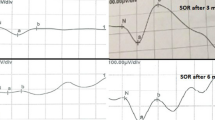Abstract
Background
Unexplained sudden visual loss after removal of silicone oil from the eye has recently been described. We report the occurrence and features of unexplained central scotoma developing with silicone oil in situ in the vitreous cavity.
Methods
A retrospective case series of five patients (from two centres) who reported a central scotoma commencing during silicone oil tamponade was studied. All patients had vitrectomy for macula-on retinal detachment, with ultra-purified silicone oil tamponade (four out of five had giant retinal tear). Investigations included visual acuity, intraocular pressure, optical coherence tomography, fluorescein angiography, visual fields and electrophysiology.
Results
All patients reported a central scotoma that appeared during oil tamponade. Visual acuity fell by a mean of 0.93 LogMAR units after onset of the scotoma. After cataract extraction and oil removal, vision remained reduced by a mean of 0.8 units. The mean duration of oil in the eye was 2.7 months when the scotoma was noted by the patient. Investigations were performed after removal of oil. Fluorescein angiography (FFA) was performed in two cases and optical coherence tomography (OCT) in five patients. No abnormality was demonstrated. Electrophysiology was performed in five patients with pattern electroretinography suggestive of macular dysfunction in four patients.
Conclusion
This is the first case series describing central scotoma associated with silicone oil in situ. Electrophysiology indicated macular dysfunction in most cases. We suggest that early removal of oil in cases with good visual potential should be considered to avoid this sight-threatening complication.


Similar content being viewed by others
References
Arafat AF, Dutton GN, Wykes WN (1994) Subclinical operating microscope retinopathy: the use of static perimetry in its detection. Eye 8:467–472
Asaria RHY, Kon CH, Bunce C, Sethi CS, Limb GA, Khaw PT, Aylward GW, Charteris DG (2004) Silicone oil concentrates fibrogenic growth factors in the retro-oil fluid. Br J Ophthalmol 88:1439–1442
Azzolini C, Docchio F, Brancato R, Trabucchi G (1992) Interactions between light and vitreous fluid substitutes. Arch Ophthalmol 110:1468–1471
Janknecht P (2004) Diagnostic and therapeutic challenges. Retina 24:293–296
Nakamura K, Refojo MF, Crabtree DV, Pastor J, Leong FL (1991) Ocular toxicity of low-molecular-weight components of silicone and fluorosilicone oils. Invest Ophthalmol Vis Sci 32:3007–3020
Newsom RSB, Johnston R, Sullivan PM, Aylward GW, Holder GE, Gregor ZJ (2004) Sudden visual loss after removal of silicone oil. Retina 24:871–877
Postel EA, Pulido JS, Byrnes GA, Heier J, Waterhouse W, Han DP, Mieler WF, Guse C, Wipplinger W (1998) Long-term follow-up of iatrogenic phototoxicity. Arch Ophthalmol 116:753–757
Refojo MF, Leong FL, Chung H, Ueno N, Nemiroff B, Tolentino FI (1988) Extraction of retinol and cholesterol by intraocular silicone oils. Ophthalmology 95:614–618
Shields CL, Eagle RC Jr (1989) Pseudo-Schnabel's cavernous degeneration of the optic nerve secondary to intraocular silicone oil. Arch Ophthalmol 107:714–717
Winter M, Eberhardt W, Scholz C, Reichenbach A (2000) Failure of potassium siphoning by Muller cells: a new hypothesis of perfluorocarbon liquid induced retinopathy. Invest Ophthalmol Vis Sci 41:256–261
Acknowledgements
We thank Mr. D.A.H. Laidlaw MD FRCOphth for contributing a case, discussing aetiology, reviewing the manuscript and approving the final version.
Author information
Authors and Affiliations
Corresponding author
Rights and permissions
About this article
Cite this article
Herbert, E.N., Habib, M., Steel, D. et al. Central scotoma associated with intraocular silicone oil tamponade develops before oil removal. Graefe's Arch Clin Exp Ophthalmo 244, 248–252 (2006). https://doi.org/10.1007/s00417-005-0076-6
Received:
Revised:
Accepted:
Published:
Issue Date:
DOI: https://doi.org/10.1007/s00417-005-0076-6




